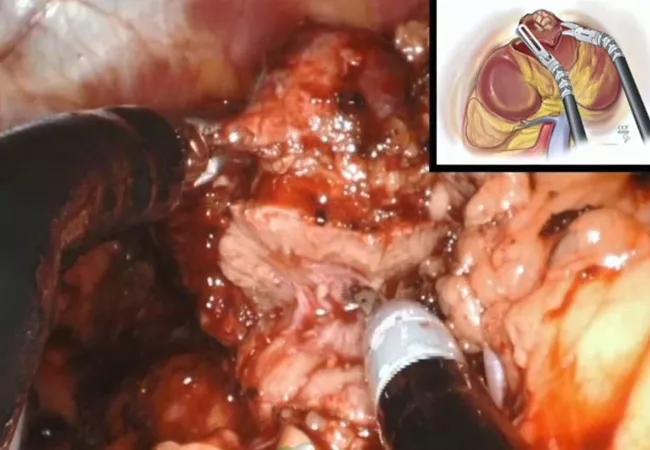Innovative technology is transforming urologic procedures

As an early adopter and innovator in robotic surgery, Cleveland Clinic has been the first to successfully use the latest advancement — a single-port robotic surgical system — to perform radical prostatectomies, transvesical simple prostatectomies and, more recently, partial nephrectomies.
Advertisement
Cleveland Clinic is a non-profit academic medical center. Advertising on our site helps support our mission. We do not endorse non-Cleveland Clinic products or services. Policy
The single-port robotic system enables the most minimally invasive surgery available by introducing three multi-jointed, wristed surgical instruments, a steerable 3D high-definition camera and an assistant accessory port into the patient abdomen through one small incision. The single arm allows 360-degree multi-quadrant access. This design provides access through limited surgical fields and permits new and different surgical routes that have not been feasible before. It has U.S. Food and Drug Administration (FDA) clearance for urologic procedures.
The single-port system makes possible a more streamlined surgical technique for urologic procedures: retroperitoneal access, which avoids the abdomen and bowel and directly reaches the prostate or kidney. In a retroperitoneal approach, surgeons can perform partial nephrectomies for tumors located on the anterior surface of the kidney, and not limited to the posteriorly located tumors – as in the case for standard retroperitoneal robotic partial nephrectomies.

Single-port excision of renal tumor
Partial nephrectomies were performed through a 2.5-cm incision located in the belly button for transperitoneal approach. During the retroperitoneal approach, the patient is positioned in the 90 degree flank position, and an incision is done just anterior to the 12th rib at the anterior axillary line for the retroperitoneal approach, with one assisted laparoscopic port inserted through the same skin incision. All cases were completed without need for conversions to multiport robotic or open approaches.
Advertisement
“The single-port robotic system allows us to work equally well on the anterior and posterior surfaces of the kidney through the retroperitoneal approach so we can avoid touching the bowel. The visualization and maneuverability are excellent,” says Jihad Kaouk, MD, Director of the Glickman Urological & Kidney Institute’s Center for Robotic and Image-Guided Surgery. The partial nephrectomy surgeries are reported in Urology.
Dr. Kaouk got an early start in using single-port robotic surgery. In 2010, he led a team that performed the first single-port urologic procedures in Europe to determine safety and clinical feasibility, which was published in European Journal of Urology. He coined the term robotic laparoendoscopic single-site (R-LESS) surgery, and he also received the Best Surgical Movie award this year at the American Urological Association Annual Meeting in Chicago for “Robotic Single-Port Partial Nephrectomy.”
Robotic radical prostatectomies are now performed through a 2.5-cm intra-umbilical incision. Using the single-port robot, the surgery is limited to the extraperitoneal space and, thus, avoids touching the bowel. The patient is kept in a flat position without the need for stirrups. Patients are typically discharged home a few hours after the procedure, which is done without narcotics. “Our aims are to decrease the morbidity of procedures, move surgeries that are inpatient to outpatient and minimize the use of drains and pain medications,” says Dr. Kaouk.
For select patients with numerous abdominal procedures, a transperineal approach is used with the single-port robot. This is a shortest route to reach the prostate and, as such, the surgical field is confined to the prostate area. Patients with colostomies may be good candidates for this approach.
Advertisement
For benign prostatic hyperplasia (BPH), surgical excision is recommended for very large prostates. Dr. Kaouk modified the robotic simple prostatectomy approach and performed transvesical simple prostatectomy from within the bladder, without going through the abdomen, to successfully remove an enlarged prostate. “The plan is not to touch the bowel for a quick post-operative recovery,” says Dr. Kaouk.
The single-port system may soon receive FDA clearance for colorectal and ENT surgery, opening new possibilities for streamlining other types of surgery. For example, according to Dr. Kaouk, the colon tumors could be removed through the anus or rectum. “It’s all about thinking outside the box and using the system for new procedures. Single-port is a valuable tool to add to our surgical options,” he says.
Advertisement
Advertisement

Pediatric urologists lead quality improvement initiative, author systemwide guideline

Fixed-dose single-pill combinations and future therapies

Reproductive urologists publish a contemporary review to guide practice

Two recent cases show favorable pain and cosmesis outcomes

Meta-analysis assesses outcomes in adolescent age vs. mid-adulthood

Proteinuria reduction remains the most important treatment target.

IgA nephropathy is a relatively common autoimmune glomerular disease that can be diagnosed only by biopsy

Oncologic and functional outcomes are promising, but selection is key